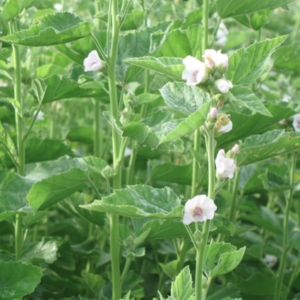S’more Fort Wayne Riverbank Plants
What can a kayaker expect to stumble across as they paddle the St. Marys, St. Joe and Maumee Rivers near downtown Fort Wayne? The short answer is: a lot. This is the first in a series of blogs describing the flora and fauna, good and bad, that we can expect to find along our riverbanks.
We begin with one of the good guys, the Marsh Mallow. No, not the sticky marshmallows we love to roast over fires and melt between graham crackers and chocolate, although marshmallows got their name from the plant. More on that soon. The Marsh Mallow, botanical name Althaea officinalis, is a flowering plant found in just a handful of locations along our rivers.
 The Marsh Mallow plants grow in clumps about 4 feet tall and about 2 1/2 feet wide. They have spearhead-shaped or three-to-five-lobed green leaves about 3 inches long and wide that grow from vertical stems. The leaves are covered with velvety, fine fuzz. Trumpet-shaped flowers about 3 inches wide and 3 inches deep grow on the top one-third of the plants. Each pollinated flower matures into a brown seedpod that pops open when ripe, releasing little black seeds (reference).
The Marsh Mallow plants grow in clumps about 4 feet tall and about 2 1/2 feet wide. They have spearhead-shaped or three-to-five-lobed green leaves about 3 inches long and wide that grow from vertical stems. The leaves are covered with velvety, fine fuzz. Trumpet-shaped flowers about 3 inches wide and 3 inches deep grow on the top one-third of the plants. Each pollinated flower matures into a brown seedpod that pops open when ripe, releasing little black seeds (reference).
Tasty marshmallows were once made from the mucilaginous material present in Marsh Mallow roots. Today, no Marsh Mallows are harmed in the production of the marshmallow, having been replaced by sugar and gelatin.
Historically, Althaea officinalis was named by the Greeks who used it as their “official healer” with “Althos” meaning healer in Greek. In fact, Hippocrates used marshmallow for healing wounds. In ancient times, Althaea officinalis was used for soothing coughs and colds along with irritated skin. This slimy plant was also eaten by the Romans and Egyptians as a vegetable on a daily basis. Also, the poor in Syria ate this plant to prevent starvation. Even in the Bible, marshmallow is mentioned as a plant used for food during times of famine. During the Renaissance period, Marshmallow was used for toothaches, stomach problems, coughs and colds, and skin irritations (Balch, 2002).
You can find Marsh Mallow in low, flood plain areas right next to the water’s edge on the St. Marys River. There are good stands at the “thumb” of Headwaters Park and across the river at Traders Point in Lawton Park. They flourish in sunny, wet spots, which frequently flood. They are opportunistic colonizers that often show up where invasive honeysuckle has been removed and sunny conditions were created. An example of this is just upstream from the Third Street Pump Station on the north bank of the St. Marys. The Althaea has thrived following the clearing of the area by volunteers. It’s relatively low height, attractive habit, and slow spread makes it an ideal riverbank resident.
So, the next time you are exploring our Rivegreenway trails or canoeing the rivers, keep an eye out for this attractive and welcomed resident. And the next time you bite into a gooey marshmallow, unleash your inner Cliff Clavin and share its origins with your friends and family.
 Blog by Alec Johnson, the landscape architect for the Fort Wayne Parks and Recreation Department. His focus is park planning, design, and management of landscape and horticulture operations.
Blog by Alec Johnson, the landscape architect for the Fort Wayne Parks and Recreation Department. His focus is park planning, design, and management of landscape and horticulture operations.

